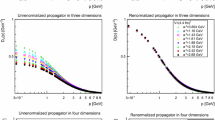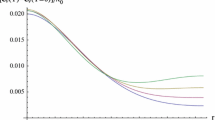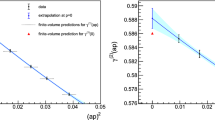Abstract
We present the results of studies of the gauge covariance of the massless fermion propagator in three- dimensional quenched quantum electrodynamics in the framework of dimensional regularization in \({d=3-2\varepsilon}\). Assuming the finiteness of the perturbative expansion, i.e., the existence of the limit \(\varepsilon\to 0\), we show that exactly for \(d=3\) all odd perturbative coefficients starting from the third order must be equal to zero in any gauge. To test this, we calculate three- and four-loop corrections to the massless fermion propagator. Three-loop corrections are finite and gauge invariant, while four-loop corrections have singularities. The terms depending on the gauge parameter are completely determined by the lower orders in accordance with the Landau–Khalatnikov–Fradkin transformation.
Similar content being viewed by others
Notes
This analysis is based on [33], where a class of more complicated diagrams with three arbitrary indices was studied and the corresponding results were also given as combinations of \({}_3F_2\)-hypergeometric functions with argument 1.
References
T. Appelquist, M. Bowick, D. Karabali, and L. C. R. Wijewardhana, “Spontaneous chiral- symmetry breaking in three-dimensional QED,” Phys. Rev. D, 33, 3704–3713 (1986); E. D. Pisarski, “Chiral-symmetry breaking in three-dimensional electrodynamics,” 29, 2423–2452 (1984); T. Appelquist, D. Nash, and L. C. R. Wijewardhana, “Critical behavior in (\(2+1\))-dimensional QED,” Phys. Rev. Lett., 60, 2575–2578 (1988); D. Nash, “Higher- order corrections in (\(2+1\))-dimensional QED,” 62, 3024–3026 (1989).
A. V. Kotikov, “Critical behavior of 3D electrodynamics,” Sov. Phys. JETP, 58, 731–735 (1993); “On the critical behavior of \({(2+1)}\)-dimensional QED,” Phys. Atom. Nucl., 75, 890–892 (2012), arXiv: 1104.3888.
D. Atkinson, P. W. Johnson, and P. Maris, “Dynamical mass generation in three-dimensional QED: Improved vertex function,” Phys. Rev. D, 42, 602–609 (1990); V. P. Gusynin, A. H. Hams, and M. Reenders, “(\(2+1\))-Dimensional QED with dynamically massive fermions in vacuum polarization,” Phys. Rev. D, 53, 2227–2235 (1996); P. Maris, “Influence of the full vertex and vacuum polarization on the fermion propagator in \((2+1)\)-dimensional QED,” Phys. Rev. D, 54, 4049–4058 (1996); V. P. Gusynin and M. Reenders, “Infrared cutoff dependence of the critical flavor number in three-dimensional QED,” Phys. Rev. D, 68, 025017, 5 pp. (2003); C. S. Fischer, R. Alkofer, T. Dahm, P. Maris, “Dynamical chiral symmetry breaking in unquenched QED\(_3\),” Phys. Rev. D, 70, 073007, 20 pp. (2004); M. R. Pennington, D. Walsh, “Masses from nothing. A non-perturbative study of QED\(_3\),” Phys. Lett. B, 253, 246–251 (1991).
V. Gusynin, P. Pyatkovskiy, “Critical number of fermions in three-dimensional QED,” Phys. Rev. D, 94, 125009, 14 pp. (2016); A. V. Kotikov, V. I. Shilin, S. Teber, “Critical behavior of \((2+1)\)-dimensional QED: \(1/N_{f}\) corrections in the Landau gauge,” Phys. Rev. D, 94, 056009, 6 pp. (2016); Erratum, 99, 119901, 2 pp. (2019); A. Kotikov, S. Teber, “Critical behavior of (\(2+1\))-dimensional QED: \(1/N_{f}\) corrections in an arbitrary nonlocal gauge,” Phys. Rev. D, 94, 114011, 9 pp. (2016); Erratum, 99, 059902, 5 pp. (2019); “Critical behavior of \((2+1)\)-dimensional QED: \(1/N\) expansion,” Particles, 3, 345–354 (2020).
N. Karthik and R. Narayanan, “Numerical determination of monopole scaling dimension in parity- invariant three-dimensional noncompact QED,” Phys. Rev. D, 100, 054514, 10 pp. (2019).
N. Dorey and N. E. Mavromatos, “QED\({}_3\) and two-dimensional superconductivity without parity violation,” Nucl. Phys. B, 386, 614–680 (1992); M. Franz and Z. Tešanović, “Algebraic Fermi liquid from phase fluctuations: ‘Topological’ fermions, vortex ‘berryons’ and QED\(_3\) theory of cuprate superconductors,” Phys. Rev. Lett., 87, 257003, 4 pp. (2001); Erratum, 88, 109902, 1 pp. (2001); I. F. Herbut, “QED\(_3\) theory of underdoped high-temperature superconductors,” Phys. Rev. B, 66, 094504, 19 pp. (2002).
K. Farakos and N. E. Mavromatos, “Gauge-theory approach to planar doped antiferromagnets and external magnetic fields,” Internat. J. Modern Phys. B, 12, 809–836 (1998).
G. W. Semenoff, “Condensed-matter simulation of a three-dimensional anomaly,” Phys. Rev. Lett., 53, 2449–2452 (1984).
V. P. Gusynin, S. G. Sharapov, and J. P. Carbotte, “AC conductivity of graphene: from tight-binding model to \(2+1\)-dimensional quantum electrodynamics,” Internat. J. Modern Phys. B, 21, 4611–4658 (2007); A. H. Castro Neto, F. Guinea, N. M. R. Peres, K. S. Novoselov, and A. K. Geim, “The electronic properties of graphene,” Rev. Mod. Phys., 81, 109–162 (2009); V. N. Kotov, B. Uchoa, V. M. Pereira, F. Guinea, and A. H. C. Neto, “Electron-electron interactions in graphene: Current status and perspectives,” Rev. Mod. Phys., 84, 1067–1125 (2012); S. Teber, “Field theoretic study of electron-electron interaction effects in Dirac liquids,” arXiv: 1810.08428.
L. D. Landau and I. M. Khalatnikov, “The gauge transformation of the Green’s function for charged particles,” Sov. Phys. JETP, 2, 69–72 (1956); E. S. Fradkin, “Concerning some general relations of quantum electrodynamics,” JETP, 2, 361–363 (1956).
K. Johnson and B. Zumino, “Gauge dependence of the wave-function renormalization constant in quantum electrodynamics,” Phys. Rev. Lett., 3, 351–352 (1959); B. Zumino, “Gauge properties of propagators in quantum electrodynamics,” J. Math. Phys., 1, 1–7 (1960); S. Okubo, “The gauge properties of Green’s functions in quantum electrodynamics,” Nuovo Cim., 15, 949–958 (1960); I. Bialynicki-Birula, “On the gauge properties of Green’s functions,” Nuovo Cim., 17, 951–955 (1960); H. Sonoda, “On the gauge parameter dependence of QED,” Phys. Lett. B, 499, 253–260 (2001).
A. Bashir, A. Kizilersu, and M. R. Pennington, “Does the weak coupling limit of the Burden– Tjiang deconstruction of the massless quenched three-dimensional QED vertex agree with perturbation theory?,” Phys. Rev. D, 62, 085002, 8 pp. (2000); A. Bashir, “Nonperturbative fermion propagator for the massless quenched QED3,” Phys. Lett. B, 491, 280–284 (2000); A. Bashir and A. Raya, “Landau–Khalatnikov–Fradkin transformations and the fermion propagator in quantum electrodynamics,” Phys. Rev. D, 66, 105005, 8 pp. (2002).
A. Bashir and A. Raya, “Gauge covariance and the chiral condenate in QED3,” Braz. J. Phys., 37, 313–319 (2007).
V. P. Gusynin, A. V. Kotikov, and S. Teber, “Landau–Khalatnikov–Fradkin transformation in three-dimensional quenched QED,” Phys. Rev. D, 102, 025013, 18 pp. (2020).
E. Marinari, G. Parisi, and C. Rebbi, “Monte Carlo simulation of the massive Schwinger model,” Nucl. Phys. B, 190, 734–750 (1981); “Computer estimates of meson masses in SU(2) lattice gauge theory,” Phys. Rev. Lett., 47, 1795–1799 (1981); F. Fucito, E. Marinari, G. Parisi, and C. Rebbi, “A proposal for Monte Carlo simulations of fermionic systems,” Nucl. Phys. B, 180, 369–377 (1981); H. Hamber and G. Parisi, “Numerical estimates of hadronic masses in a pure SU(3) gauge theory,” Phys. Rev. Lett., 47, 1792–1795 (1981).
D. Hatton, C. T. H. Davies, B. Galloway, J. Koponen, G. P. Lepage, and A. T. Lytle [HPQCD Collab.], “Charmonium properties from lattice QCD+QED: Hyperfine splitting, \(J/\psi\) leptonic width, charm quark mass, and \(a^c_\mu\),” Phys. Rev. D, 102, 054511, 32 pp. (2020).
P. I. Fomin, V. P. Gusynin, V. A. Miransky, and Yu. A. Sitenko, “Dynamical symmetry breaking and particle mass generation in gauge field theories,” Riv. Nuovo Cim., 6, 1–90 (1983); V. A. Miransky, Dynamical Symmetry Breaking in Quantum Field Theory, World Sci., Singapore (1994).
C. N. Leung, S. T. Love, and W. A. Bardeen, “Spontaneous symmetry breaking in scale invariant quantum electrodynamics,” Nucl. Phys. B, 273, 649–662 (1986); W. A. Bardeen, C. N. Leung, and S. T. Love, “Aspects of dynamical symmetry breaking in gauge field theories,” 323, 493–512 (1989); B. Holdom, “Continuum limit of quenched theories,” Phys. Rev. Lett., 62, 997–1000 (1989); U. Mahanta, “Critical behavior in quenched qed to all orders in the coupling,” Phys. Lett. B, 225, 181–185 (1989).
V. P. Gusynin, A. W. Schreiber, T. Sizer, and A. G. Williams, “Chiral symmetry breaking in dimensionally regularized nonperturbative quenched QED,” Phys. Rev. D, 60, 065007, 12 pp. (1999).
A. V. Kotikov and S. Teber, “Landau–Khalatnikov–Fradkin transformation and the mystery of even \(\zeta\)-values in Euclidean massless correlators,” Phys. Rev. D, 100, 105017, 10 pp. (2019); “Landau–Khalatnikov–Fradkin transformation and hatted \(\zeta\)-values,” Phys. Part. Nucl., 51, 562–566 (2020); “Landau–Khalatnikov–Fradkin transformation and even \(\zeta\) functions,” Phys. Atom. Nucl., 84, 105–107 (2021).
A. James, A. V. Kotikov, and S. Teber, “Landau–Khalatnikov–Fradkin transformation of the fermion propagator in massless reduced QED,” Phys. Rev. D, 101, 045011, 12 pp. (2020).
R. Jackiw and S. Templeton, “How super-renormalizable interactions cure their infrared divergences,” Phys. Rev. D, 23, 2291–2304 (1981); O. M. Del Cima, D. H. T. Franco, and O. Piguet, “Ultraviolet and infrared perturbative finiteness of massless QED\(_3\),” Phys. Rev. D, 89, 065001, 4 pp. (2014).
N. Karthik and R. Narayanan, “Flavor and topological current correlators in parity-invariant three-dimensional QED,” Phys. Rev. D, 96, 054509, 10 pp. (2017).
A. F. Pikelner, V. P. Gusynin, A. V. Kotikov, and S. Teber, “Four-loop singularities of the massless fermion propagator in quenched three-dimensional QED,” Phys. Rev. D, 102, 105012, 9 pp. (2020).
A. V. Kotikov and S. Teber, “Two-loop fermion self-energy in reduced quantum electrodynamics and application to the ultrarelativistic limit of graphene,” Phys. Rev. D, 89, 065038, 24 pp. (2014).
B. Ruijl, T. Ueda, J. A. M. Vermaseren, and A. Vogt, “Four-loop QCD propagators and vertices with one vanishing external momentum,” JHEP, 06, 040, 49 pp. (2017).
B. Ruijl, T. Ueda, and J. A. M. Vermaseren, “Forcer, a FORM program for the parametric reduction of four-loop massless propagator diagrams,” Comput. Phys. Commun., 253, 107198, 23 pp. (2020).
R. N. Lee, “DRA method: Powerful tool for the calculation of the loop integrals,” J. Phys.: Conf. Ser., 368, 012050, 7 pp. (2012).
H. R. P. Ferguson, D. H. Bailey, and S. Arno, “Analysis of PSLQ, an integer relation finding algorithm,” Math. Comput., 68, 351–369 (1999).
R. N. Lee, A. V. Smirnov, and V. A. Smirnov, “Master integrals for four-loop massless propagators up to transcendentality weight twelve,” Nucl. Phys. B, 856, 95–110 (2012).
R. N. Lee and K. T. Mingulov, “Introducing SummerTime: a package for high-precision computation of sums appearing in DRA method,” Comput. Phys. Commun., 203, 255–267 (2016).
V. Magerya and A. Pikelner, “Cutting massless four-loop propagators,” JHEP, 12, 026, 57 pp. (2019).
A. V. Kotikov, “The Gegenbauer polynomial technique: The evaluation of a class of Feynman diagrams,” Phys. Lett. B, 375, 240–248 (1996).
S. Laporta, “Building bases for analytical fits of four-loop QED master integrals,” PoS (LL2018), 303, 073, 9 pp. (2018).
Acknowledgments
The author thanks the Organizing Committee of the International Conference “Models in Quantum Field Theory” for the invitation.
Author information
Authors and Affiliations
Corresponding author
Ethics declarations
The author declares no conflicts of interest.
Additional information
Translated from Teoreticheskaya i Matematicheskaya Fizika, 2023, Vol. 216, pp. 548–558 https://doi.org/10.4213/tmf10475.
Appendix: Details of calculations
To calculate the unrenormalized fermion self-energy in QED\({}_{3}\) up to the four-loop order, the authors of [24] used the QCD result for the unnormalized quark propagator. The QCD results valid in an arbitrary space–time dimension \(d\) and for an arbitrary gauge are given by a set of master integrals [26], and are also part of the FORCER package [27] designed to reduce the four-loop integrals of the massless propagator. The QED\({}_{d}\) limit follows from the QCD result by substituting
To calculate the required four-loop propagator integrals in \(d=3-2\varepsilon\), the dimensional recurrence and analyticity (DRA) method [28] was used, giving results in the form of fast convergent sums. After performing the summation, high-precision numerical values for integrals in an arbitrary space–time dimension can be reconstructed using the PSLQ algorithm [29] if a suitable basis of transcendental constants is specified; this yields analytic results.
We note that near \(d=4\), such calculations give expansions of all the necessary master integrals [30]. The results are well known and are available as the input in the SummerTime package [31] along with the package itself (see [32]).
The case \(d=3-2\varepsilon\) is less known and was recently considered in [31], where the \(\varepsilon\)-expansion of the majority of the master integrals needed for our calculation is given. Successful reconstructions around \(d=3\) were performed there using a basis of transcendental constants consisting of only multiple zeta values (MZV) and alternating MZVs. As already noted in [31], such a basis is too restrictive to represent all master integrals, and therefore some of them remained unreconstructed.
In [24], all necessary integrals were successfully reconstructed and agreement was found with the results in [30] using a basis consisting of MZVs and alternating MZVs. In addition, one more constant, unknown in [31], was determined after a careful analysis of one of the integrals, namely, \(D_1(p)\),
The diagram \(G(p\kern1pt;\alpha,1,\beta,1,1)\) was studied in [25], where several of its representations were presented as combinations of \({}_3F_2\)-hypergeometric functions with argument 1.Footnote
This analysis is based on [33], where a class of more complicated diagrams with three arbitrary indices was studied and the corresponding results were also given as combinations of \({}_3F_2\)-hypergeometric functions with argument 1.
Considering representations in the case \(\alpha=\beta=1/2\), Andrey Pikelner noticed that only generalized polylogarithms appear with the argument given by a fourth root of unity. By extending the PSLQ framework to include the full set of polylogarithms at a fourth root of unity, he successfully reconstructed the analytic result for \(G(p\kern1pt;1,1/2,1,1/2,1)\) asThis analysis is based on [33], where a class of more complicated diagrams with three arbitrary indices was studied and the corresponding results were also given as combinations of \({}_3F_2\)-hypergeometric functions with argument 1.
The diagram \(G(p\kern1pt;1,1/2,1,1/2,1)\) is useful in calculations in effective theories. Moreover, following the transformations discussed in [33], we see that for \(d=3\),
Rights and permissions
About this article
Cite this article
Kotikov, A.V. On the Landau–Khalatnikov–Fradkin transformation in quenched \(\mathrm{QED}_3\). Theor Math Phys 216, 1373–1381 (2023). https://doi.org/10.1134/S0040577923090118
Received:
Revised:
Accepted:
Published:
Issue Date:
DOI: https://doi.org/10.1134/S0040577923090118




